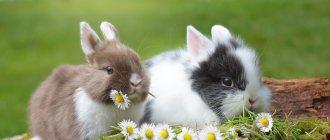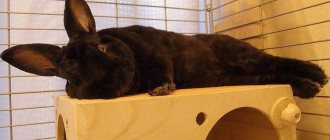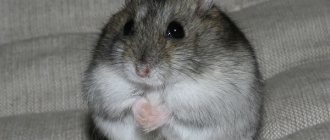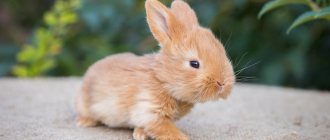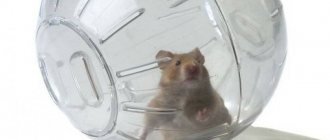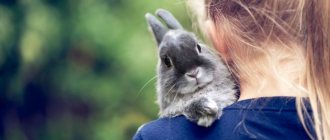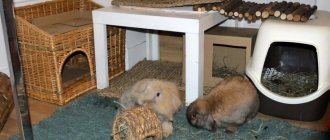Is it worth having a rabbit in an apartment, pros or cons?
It is not human nature to listen to other people's opinions. How much did you listen to your mother, and then say, Mom, you were right, and even more so the opinion of Internet advisers on choosing animals. Meanwhile, rabbits are exotic animals for apartment keeping, and exotic animals require special knowledge. Therefore, read our advice, and then decide for yourself whether you are ready to take responsibility for a small living creature.
So, the topic of today’s review is decorative rabbits: pros and cons. How difficult is it to care for a small pet, how to feed it and what should you be wary of? Read about all this right now.
Netherland dwarf rabbit
The ancestor of the breed is the red-eyed Hermelin. They have spread throughout the world. These rabbits were brought to Russia from Finland in 2014. There are two lines of the breed: English and American.
Peculiarities:
- Weight: 900-1150 g.
- Ears: 5-7.5 cm, straight.
- Coat type: medium.
- Any colour.
- Cost: 4-8 tr.
The ideal weight of an adult Netherland rabbit is 950 grams. The body is compact, the body has a rounded short format. The length of the ears varies from 5 to 7.5 cm. The breed standard includes 37 colors: solid, agouti, Siamese, tan, etc.
Decorative and productive rabbits
Rabbits can be wild or domestic. Read all about wild rabbits. Domestic rabbits are divided into two types of economic use.
- Productive breeds are grown exclusively for meat, skins, and fluff.
- Decorative breeds and their varieties are dwarf and are raised only as pets.
In 1912, zoologists divided rabbits into two orders - rodents proper and lagomorphs. Since that time, rabbits, hares and pikas began to be classified as rodents (lagomorphs). So don't call rabbits rodents.
Read more: Why rabbits are not rodents
"Rex"
The very first short-haired rabbits appeared in France in 1919. For their unusual and valuable fur, they were given a sonorous name - “castor rex” (king of beavers). The resemblance to a beaver is really obvious - the animal has a red-brown fur color. And he received the title of king for the quality of the skin, which is very reminiscent of a chinchilla’s fur coat.
“Rex” is a dwarf rabbit (you can see the photo below), which has low hair, downy and guard hairs of almost the same length. They are half as long as their counterparts. This breed is characterized by underdeveloped whiskers - they are much smaller than those of other breeds and are often curved. At a very young age, a rabbit of this breed can be distinguished only by its antennae. When this species is crossed with ordinary ornamental individuals, the skins of the first-generation rabbits do not resemble the “Rex”.
When you can’t get a decorative rabbit, pros and cons
It is strictly forbidden to purchase rabbits.
Don't get a rabbit as your first pet. Do not get a rabbit to play mother-daughter games for girls 10-12 years old. Don't let your first experience of future motherhood end with the death of your pet. The risk of death is very high. It's better to adopt a kitten from a shelter. This will be the best example of kindness for the expectant mother. Cats, physiologically, are much closer to people. They have the same type of digestion, they are smarter, communicate easier with people, and are more adequate.
Teach children responsibility and kindness, and not to fulfill the child’s every whim. Read the great Ukrainian and Russian teacher V.A. Sukhomlinsky.
Start at your discretion, but remember the characteristics of long-eared animals at home.
- Do not have pets under the influence of momentary sympathies.
- If you don’t know, the second most frequently asked question from lovers of decorative rabbits is the question in the search engine: why do rabbits smell? I’ll get ahead of myself and say that the smells are overfeeding the pet with treats.
- Not many people know that eating feces in rabbits is a physiological feature that cannot be weaned off. In all lagomorphs (lagomorphs), cecotrophy is a physiological feature of digestion. The rabbit is not a rodent; it belongs to an order parallel to rodents.
- For young families, an exception: if one of the members has been the owner of the animal for a long time. Build your relationship first.
- If you plan to have a little one. Definitely, the animal will interfere and distract the young mother from new and difficult responsibilities; do not torment the mother and the animal.
- One of the family members is against pets. Avoid unnecessary scandals with loved ones and family.
- Like a thoughtless purchase, at the child’s first request. Parents will take care, and the child, instead of kindness, will learn to shift his worries onto the shoulders of others. Or immediately take on this burden and explain to the child that this is not his whim, but the decision of the family council.
- The area of the home is so small that there is nowhere to turn around. Sometimes our housing is so small that its area resembles an enclosure for a large dog.
- Rented housing is also not an option. Rental conditions may change; constant moving does not contribute to normal conditions for the pet.
There are other options, they can be listed for a long time, based on the characteristics of each family, and determine for yourself the pros or cons of a decorative rabbit in the house. But if you are determined to get a rabbit, then read on, perhaps you will only become stronger in your desire to care for a cute bunny.
Rabbit keeping experience
My experience:
I had an Angora and a fox rabbit. The Angora hare lived with us from the age of two months and from the very first days she became addicted to fresh parsley, which became her favorite delicacy. Our bunnies loved playing with the duct tape, tearing wallpaper, and snorting at each other. They quickly learned to open the cage door with their paws. Their characters turned out to be different. Angora Ushanya constantly hovered around our legs, licking and biting us. While the second rabbit, Tail, behaved more calmly.
Unfortunately, despite regular cleaning of the cage, the smell from them could be felt in the apartment.
Experience of one site visitor:
“I still have very little experience in keeping rabbits. Less than 5 months. The rabbit loves to walk on the grass near the house. Shows interest in neighbors' cats, although he often has to run away from them. Our summer cottage has become extremely popular with the neighbors' cats. Loves carrots and apples, carrots more.”
An animal is not a child's toy
This is the first thing to realize. Despite their miniature size and usually affectionate nature, rabbits will require attention, affection, special food, and special care products.
Dwarves are sometimes very aggressive, even more so than giants
Before you get a rabbit at home (and this must be explained to your children), you need to take care of the mandatory conditions for keeping a dwarf rabbit at home:
- spacious cage;
- the rabbit owner has free time when he needs to take his pet for a walk;
- proper nutrition and veterinary care;
Rabbits do not tolerate moving and travel well. How to transport rabbits and other animals within the country and abroad, find the section veterinary certificate form 1 veterinary Rosselkhoznadzor. It is clear that it is difficult to understand the cavalcade of documents, but find your region in the search at the top of the page of this site. If necessary, contact inspectors in your region by phone. We are obliged to help you. In any case, you will know what requirements need to be met when crossing the border with an animal and more. Perhaps the information from the site will help you make a choice when buying decorative rabbits. Rabbits can be long-haired or short-haired.
Some notes from the owners' experience
It is the reviews and experience of owners of furry animals that help them decide whether to get a rabbit or not. A few recommendations:
- when traveling with rabbits, you need to prepare the same package of documents as when transporting cats/dogs (a passport with vaccination records and a “fresh” certificate from a veterinarian are required);
- Rabbits are social animals and if the owners are constantly at work, then the animal may not fit into the family, will be scared of everyone and may even bite. Some owners note that the rabbit recognizes one owner and is reluctant to go into the arms of other people;
- If there are small active children in the family, then it is not recommended to have a small pet. You can purchase an animal for a child aged 10-13 years. Small children will not be able to seriously care for the animal and may frighten it;
- rabbits are calmer than female rabbits. Although this feature is also determined by the character of the individual. Fluffies get along well with other pets;
- owners like that the rabbits are not allowed to walk outside, and that minimal time is required for servicing the animals and cleaning the cage.
It is possible to train the animal to respond to its name and to its litter box. It is worth remembering that a rabbit is an animal that bites and is capable of throwing itself in the face. They also take into account the timid nature of animals; they should not be left alone for a long time. Cute creatures evoke affection in both children and adults. Animals require a minimum of care and always respond to affection and attention. In order for animals to fully develop, it is necessary to choose the right food and arrange a suitable place for keeping them.
Is it worth having a rabbit for children? Pros or cons?
The kids really like cute miniature creatures. However, the child needs to understand that squeezing a “living toy” will have to be done carefully. It is necessary to take into account not only the desires of the child, but also the desires of the rabbit; although he is small, he is a living creature.
The rabbit does not bite often - more often it just hits the offender hard with its hind legs
Photo. Before buying a rabbit, we present the picture like this
- At the slightest change it can become aggressive.
- Baby rabbits should be purchased only from trusted breeders, or at a pet store.
Active and friendly
Dutch long-eared cats are not aggressive and most often do not cause trouble to their owners. Rabbits are attractive due to their docile nature and the fact that they are very friendly to children and everyone around them.
After acquiring a miniature animal, it must be given time to adapt to new conditions. Rabbits themselves are quite shy.
This means that you need to be doubly careful. If you don’t disturb the long-eared dog after the move, he will soon begin to loosen up and trust his owner.
Miniature individuals are very active and enjoy exploring the world around them. One can also note their intellectual abilities, which are slightly higher than those of other breeds.
Can a decorative rabbit be huge?
It is believed that a home decorative pet must be a small animal. This is wrong. Maybe you are looking for a huge decorative rabbit. Then the old breed Flanders rabbit is your choice. The history of breeding this breed is very interesting and full of mysticism. Flandre is the largest rabbit, with an average weight of 12 kg. Flanders are common domestic rabbits in the United States that are bred as pets. In America, a program has been developed to teach children how to care for animals using the example of Flanders. The main breeds of giants, rabbit and ram, including dwarf breeds. The Rex breed group is interesting.
The most popular breeds
There are several dozen breeds of decorative rabbits in the world. All of them were bred by breeders. Many of them have gained great popularity among animal lovers.
Attention! When choosing an animal to keep at home, you need to take into account that long-haired pets are more difficult to care for than short-haired ones.
Colored dwarf
Colored dwarfs are miniature animals whose weight varies within 1 kg. The animal has a cylinder-shaped body, a rounded head, and short ears. The coat is very thick, short and shiny. Caring for decorative rabbits of this breed is not difficult. Colored dwarfs are presented in a wide range of colors. In addition, they have a friendly nature.
Lion head
This decorative rabbit comes from Belgium. Thanks to the thick fur on his head and neck, he looks like a lion. Dwarf lionhead rabbits grow up to 1.5 kg. These are smart, playful animals with a good-natured disposition. Such an animal will become a good friend for children.
Lop-eared ram
Fold sheep are native to France. They have one peculiarity - large hanging ears. Due to the wide forehead, wide-set eyes and dense build, the animal resembles a ram. These pets are easy to care for - their fur, although thick, is not long. Fold sheep can be of a variety of colors - blue, white, gray, yellow.
Hermelin
The breed is of Polish origin. Hermelines are miniature animals weighing 1-1.5 kg. Their body is fit, their head is oval, their ears are erect and small, and their eyes are blue. The coat is short but very thick.
Dutch Fold
Representatives of this breed resemble a plush toy. They have chubby cheeks, drooping ears and beautiful short fur. The rabbit weighs no more than 1.5 kg. These are calm animals that are willing to be held, allow themselves to be petted, and love active games.
Angora dwarf
Such a pet needs to be carefully looked after - it is all covered with long and soft hair, even its ears. A luxurious fur coat should be combed every day, otherwise it will become tangled.
Reference. Decorative rabbits grow until they are six months old, after which weight gain stops.
Is it possible to teach a rabbit to pee and poop in the same place?
If the rabbit lives only in a spacious cage, then it is possible to train it, since these animals are very clean and usually choose a secluded place in their home for their excrement. The right tray is that very secluded place. However, remember, when released from the cage, he will most likely pea incessantly and this is also the norm, this is how he “confuses” his tracks from predators.
Are you ready to tolerate a poor animal for 5-7 years? If yes, then let's talk about feeding
Cage selection and equipment
Before purchasing a decorative rabbit, you should take care to create favorable conditions for its maintenance. You need to buy a comfortable cage and equipment. The rodent will spend most of its time in its home, so it should be comfortable.
It is also important to find a suitable place in the apartment to place the pet. This could be a hall, a living room, or a distant, quiet room.
It is better to place the home of a decorative rabbit on a cabinet or table in the back of the room so that it is not exposed to direct sunlight from the window.
Important! A rodent's cage cannot be located near a heating radiator - it is too hot there in winter.
Dimensions of the home
Decorative rabbits are kept in cages. When choosing a home for a rodent, the breed of the rodent is taken into account. There are many breeds for home keeping and, as a rule, these are medium-sized animals whose weight ranges from 1.5 to 2.5 kg.
True, there are mini rabbits - these are tiny rodents weighing from 600 g to 1.4 kg.
Attention! Before you buy a cage to keep a rabbit, it is important to decide what breed you plan to have.
For small decorative rabbits, whose weight does not exceed 1.5 kg, a dwelling with dimensions of 0.8 x 0.6 m is suitable. To keep larger rodents, you should buy a larger cage - 1 m long and at least 0.6 m wide. The height of the structure should allow the pet to stand on its hind legs, which is approximately 60 cm.
If you plan to breed decorative rabbits, you will need 2 cages. One is for keeping the male, the other is for the female. You can purchase a two-section design, the parts of which are separated by a partition.
The main thing is that each pet has enough free space inside. To keep the rabbits after leaving the mother, you will need a separate home.
Design requirements
A cage for a decorative rabbit should be comfortable both for its future inhabitant and for the owner of the rodent. It is important that it is easy to care for. It’s good if the product is equipped with a retractable plastic tray, it is easy to clean and remove droppings. The cage should be made of either wood and metal or galvanized mesh and be equipped with a securely closing door.
Important! When purchasing a home for keeping a decorative rabbit, it is important to make sure that there are no sharp elements inside that could injure the animal.
Inventory
A decorative rabbit will need 2 feeders - one for dry food, the other for succulent food. You also need to buy a sennik - a box for dry grass. Hay should not lie on the floor along with rodent excrement. Still need a drinking bowl. It is better to give preference to automatic or nipple. It is attached to the outside of the cage, and the spout that supplies water goes inside through the grate. This type of drinker cannot be knocked over. In addition, the water in it remains clean longer, does not bloom, and caring for such a container is very simple.
Another important attribute of a decorative rabbit’s home is a house. It is necessary for the pet to hide there when it is afraid of something. This is a kind of shelter where the animal can rest and recover from stress.
The house will serve as a nest for a rabbit who is going to become a mother. It is selected taking into account the size of the animal. The pet should be comfortable lying and turning around inside.
A tray for a decorative rabbit is installed in the apartment. It is quite bulky, so it is unlikely to fit in the cage. It is difficult to train a pet to go to the toilet in a specially designated place, but many succeed. Decorative rabbits go into a tray with litter when they are let out to walk around the house.
When they are in their home, they relieve themselves right on the floor. Therefore, it is advisable to pour filler - straw or wood shavings - onto the bottom of the cage.
What food does a decorative rabbit need?
The rabbit comes to the feeder very often during the day: from 20 to 60 times. No, you can fill the feeder once a day, he just needs to always have a feeder full of food. Rabbits salivate constantly, and not like other animals, before and during meals. In addition, his front teeth - incisors - are constantly growing, he needs to grind them down, or rather, he grinds them down himself when he gnaws on hard twigs. Otherwise, a disease called malocclusion develops.
The rabbit is a granivorous animal, and not a ruminant like a cow. The cow has four stomachs and can digest low-nutrient grass. A rabbit, like a cat and a dog, has only one stomach. However, in the diet of a decorative rabbit, approximately 70% of the food is hay, grass, and twigs. Grain feed in the diet of a decorative rabbit is no more than 30%. They purchase grain feed at a pet store or make their own mixtures of grains. Grain is better absorbed in crushed form; coarse grinding is required; grain ground into flour is not allowed to be given to rabbits.
Cecotrophy is a way to assimilate grass and grain as completely as possible, an analogue of ruminant rumination
Photo. But what can happen if you don’t give a decorative rabbit, for example, twig food?
Which animal is best for home?
Rabbit or chinchilla?
When choosing between a decorative rabbit or a chinchilla, many choose the first animal because:
- Chinchillas are nocturnal animals. rabbits are cheaper than chinchilla puppies;
- a wide variety of breeds, while chinchillas look about the same;
- chinchillas are more timid;
- change of environment and stress worsen the health of chinchillas;
- chinchillas are more active at night, and rabbits - during the day;
- For chinchillas, they place bathing containers with clean sand, which they actively rake, and it ends up outside the cage.
A big plus in favor of a decorative rabbit rather than chinchillas is the availability of veterinary care, since doctors have more experience in working with rabbits.
Rabbit or guinea pig?
Pigs are noisier.
According to the conditions of detention, these animals are approximately the same. There are different breeds of both species.
If you are not ready to listen to sounds from pigs, then buy a rabbit, they are silent.
How do rabbits get along with other animals?
The question is controversial whether it is worth starting a zoo at home from different species of animals that are antagonists in nature. If you have even the slightest idea about animal psychology, start one. If you have no idea about competition in the animal world, hierarchy, who to feed first, who to feed later, who needs to be petted, who needs to be reined in. Then don't start it. Remember that keeping a rabbit at home is more difficult than keeping dogs and cats.
Photo. Oh, trouble, trouble! The owner also decided to get a rabbit. Vasya, maybe we can eat it, huh?
Is it worth getting a rabbit in a city home or apartment? If you have pets that can eat rabbits in the wild, think carefully.
For example.
- It is possible to keep a rabbit together with reptiles if snakes and other reptiles live in a secure terrarium.
- Dogs. A predator can easily provoke an “interspecies” scandal and eat the baby rabbit on the very first day of purchase. It is usually not recommended to have rabbits in homes where there are dachshunds or other dogs designed for burrowing.
- Cats. These animals are very jealous, and underneath the outward indifference and play there may be a showdown. There are known cases of cats leaving home when a competitor appears.
- Birds. Shared content is almost always allowed. Birds and rabbits are animals of different elements (heaven and earth).
Do you want to get a rabbit? Here's what you need to know
Contents hide
Do you want to get a rabbit? Here's what you need to know
Wonderful fluffy rabbits have their own army of loyal fans. Agree, it is impossible to pass by enclosures with rabbits sold in pet stores indifferently. I just want to hug this wonderful creature to myself as soon as possible. We are probably not the only ones with such thoughts in our heads! Are you thinking about bringing home a little bunny? Read this useful and informative review article - it will help you make a choice.
Is a rabbit right for you? The first thing I want to say is that a rabbit is a long-term responsibility. You will share a house and shelter with him for at least 5-7 years. Your rabbit will require proper care from you and should be fed and treated properly. In addition, a rabbit is an animal that should not be owned, as they say, “with your last money.” You are ready? Then you will get a wonderful, affectionate pet, with whom it is a pleasure to communicate.
It is important to choose a healthy rabbit. It is for this reason that we advise you to purchase an animal from trusted breeders - the chances of buying a known sick fluffy in this case are reduced to a minimum
Pay attention to the appearance of the animal you like. It should not be lethargic and lifeless
Before buying, it is best to prepare, read everything you find about the breed you like. Remember that the temperament of rabbits (from breed to breed) can vary significantly. Don't refuse the option to adopt a rabbit for free from a shelter!
Choosing a cage for a rabbit. The principle “the more the better” prevails here. Choose a spacious cage, consider the number of animals you plan to house
But take into account the fact that the cage will also have to be cleaned periodically! Therefore, everything should be simple and as functional as possible. The rabbit should fit freely in the cage and have some space to move around
Do not forget that it is not advisable to keep a rabbit in a cage twenty-four hours a day! This is a social animal; it needs exercise, training and communication with its owner and outside the cage. Decide in advance on the type of bedding, filler, buy toys and other accessories.
Feeding the rabbit correctly. In pet stores you will find an assortment of ready-made granulated food, selected specifically for rabbits. Of course, it can and should be used, but your pet’s diet will be incomplete without fragrant hay, and in the summer - without tasty meadow grass and fresh vegetables. Proper nutrition is the key to the health of your furry pet. The main condition is as many high-fiber foods as possible.
Rabbit toys. Rabbits are playful, active and inquisitive animals that play with their owners with visible pleasure. Provide them with a selection of suitable toys for play and variety of leisure activities. It is advisable that your rabbit is constantly busy with something interesting and attractive. Toys are an indispensable condition for maintaining good psychophysical shape of the animal.
We train a rabbit. Some breeds of rabbits can be trained to use a litter box (much like cats or ferrets), and cleaning problems will be much less. However, there are also “untrainable” specimens, and those that will require a lot of patience and attention from you. Variants of natural, normal behavior of rabbits - a lot of chewing and a lot of digging
With the first condition everything is more or less clear, with the second you will have to work hard: it is important to equip the cage and protect it correctly!
Caring for a rabbit. You will need the following: rabbits need to be combed, bathed from time to time, and their nails trimmed periodically. Don't neglect these procedures!
About the rabbit's health. Before purchasing a rabbit, call nearby clinics. Check to see if you and your pet will be welcome there. The fact is that veterinarians usually receive a narrow specialization to work with these animals. It turns out that there are not many qualified specialists around, and the prices for their services are steep. The main conditions for maintaining the health of a rabbit are adequate and proper nutrition, physical activity, constant communication with the owner, and regular preventive examinations by a veterinarian. Also, be sure to spay or neuter your rabbit to prevent many potential problems.
Rabbit and man
Wild rabbits live in groups and do not tolerate loneliness well. This also applies to decorative rabbits. Believe it or not, it is important for your pet to feel like a member of the group. Such a group could be another rabbit, a family of people, a person. A rabbit may consider animals of other species that were raised at the same time as its family. The rabbit needs to determine its place in the pack, who to obey, who to dominate. Ignoring the animal’s innate reflexes ends in the latter’s unmotivated aggression.
Read more: Why does a rabbit bite?
Hermelin red-eyed and blue-eyed
There are two varieties of hermelin: with red or blue eyes. The first appeared at the end of the 19th century. Blue-eyed hermelines were obtained at the beginning of the 20th century. Initially, a weight of 750 grams was considered ideal, but in such females fertility was noticeably reduced.
Characteristic:
- Weight: 1100-1350 g.
- Ear length: 3.5-7 cm, straight.
- Wool: medium.
- Color: white.
- Price: 4-10 t.r.
In 1992, Austria released a new standard in which the weight of animals was changed. Hermelines have a strong build. The body is cylindrical, the limbs are short. The coat must be white.
At what age is it better to buy a rabbit?
- Before purchasing, you must check the age of your pet. Do not take baby rabbits immediately after weaning from their mother. The approximate age suitable for purchasing a baby rabbit is 3-4 months. This age corresponds to 10-12 years in humans.
- Until 3-4 months, all necessary vaccinations and antiparasitic treatments are given, which is mandatory for decoratively bred breeds that come into close contact with humans. Subsequent vaccinations are given or not given based on the likelihood of contact (direct or through owners) with other rabbits. Rabbit infections are specific, so contagious diseases of dogs or cats are not dangerous for rabbits.
Rabies is dangerous for rabbits only when bitten and the saliva of a sick animal gets into the wound. There is a possibility of rabbit rabies in rural areas; in the city the danger is purely hypothetical. Although, to be honest, cases of rabies in rabbits are extremely rare, more often domestic animals become infected through the bites of foxes (dogs, cats, cows).
Having figured out at what age to adopt a fluffy (or smooth-haired) pet, you need to prepare a spacious cage, a supply of food, twigs that can be chewed to grind down teeth, and a tray to which the rabbit will need to be accustomed. It is not recommended to take adult rabbits, since the animals already have established habits, and they react to shift changes with illness, depression, and even sudden death.
When should you contact a veterinarian?
Warning signs: excessive nasal discharge, sneezing, tears, runny nose, swollen eyelids, pus, grinding of teeth, poor or no appetite, distended abdomen, lack of bowel movements or liquid feces, formations and tumors on the body, bald spots on the coat and copious amounts of it. hair loss, dirty fur, wet face, rapid breathing and heart palpitations.
Each of these symptoms may be the result of an animal illness. Once any of these signs are detected, the rabbit must be taken to a veterinary clinic immediately, because the disease spreads quickly and death can occur quickly.
Who to choose, boy or girl
There are pros and cons for males and females. Care and maintenance for individuals of different sexes is not particularly different. Females, like males, can write by. Rabbits mark territory. Not smelly glands on the chin, smelly glands under the tail. Friendliness and affection, as well as behavior, depend on the genetic component, and not on the sex or species difference of the animal. Raising a rabbit can be done with effort, health monitoring, and genuine friendliness, which animals pick up on.
How to choose the right one
In order not to get lost in the variety of breeds, you need to correctly determine the criteria for your choice. Find out more about the temperament of the breed you think is right for you, and also consider the costs you'll incur.
Breed selection criteria:
- degree of friendliness;
- behavior towards strangers;
- degree of daily activity;
- weight - miniature breeds should not be purchased by families with children, in order to avoid injury to the rabbit;
- disease resistance;
- need for daily care.
Ask the breeder about the breed and characteristics of the rabbits in a particular litter. While you are communicating, observe the behavior of the kids. Don't choose a pet based solely on what you know about the breed. Make sure the rabbit you choose is healthy. He must be active and energetic. The fur is shiny, without bald spots and parasites.
Important! For families with children under 13 years old, a male is more suitable
-
he is less timid than the female.
This applies to sudden outbursts of tenderness on the part of children. Run your hand over the body on both sides - you should not feel any signs of damage or swelling. Both sides of the body should feel the same to the touch.
How to determine the health of a rabbit before purchasing
You need to check the condition of your future pet before purchasing. It is advisable to purchase rabbits not from hand, but from pet stores, although they can deceive you in a store. Don't trust sellers, trust your eyes. But if the animal breeder is trustworthy and can provide all the necessary documents and confirm vaccinations, listen. There is no particular reason for breeders to deceive. Once he deceives, then few people will take animals from him.
If there is no one to advise, pay attention to the following points:
- Eyes. The eyes and nose should be clean, without signs of any discharge;
- Activity. Little rabbits should be active and inquisitive, sniff and inspect the territory, and easily make contact during inspection;
- Fur. A good indicator of health is clean fur, no bald spots, bald spots, combs or scratches;
- Appetite. A good appetite for a baby rabbit is the key to health.
- Ears. The inside of the ear must be clean
I almost forgot. At the age when I advise you to buy a pet, see point 3. The rabbit sheds.
Pay attention to this, consult with the breeder, and avoid the first experience of unnecessary and useless treatment. Watch the rabbit molt. Why does hair fall out, why does one go bald.
Do not pay attention to the temperature of the rabbit's ears, dryness or wetness of the nose. If you are not a specialist in the field of veterinary medicine, you should not pay much attention to this indicator; you can easily make a mistake. Hot ears and a dry nose of a rabbit are of clinical significance if the baby has no appetite and constantly lies in the far corner of the cage.
Care
In terms of care, rabbits, compared to other pets, are quite
unpretentious. They are always clean, so there is no need to bathe them. Another reason not to bathe rabbits is that rabbit fur takes a long time to dry, which can cause the rabbit to catch a cold.
The rabbit needs to have its claws trimmed in a timely manner or taken to a special salon. Since overgrown claws can cause pain to the rabbit and even twist the fingers. It is also recommended to have your rabbit's health checked by a veterinarian in a timely manner. Particular attention should be paid to the ears, eyes and skin of the rabbit.
Diseases of rabbits for which there are vaccines
To be fair, it should be noted that infectious diseases of rabbits, including decorative ones, are not fatal to humans. There are no known cases of rabies in domestic rabbits, although rabbits are susceptible to the rabies virus.
When traveling on trains and planes, anti-rabies (rabies) vaccination is mandatory.
Infection of rabbits from hunting dogs is unknown. Rabbits do not suffer from tick-borne encephalitis, Lyme borreliosis and other infections transmitted by ixodid tick bites.
When a rabbit is bitten by a tick, fatal allergic reactions are possible, but they are not infectious.
It is necessary to vaccinate an ornamental rabbit only if the animal is a breeding animal, participates in exhibitions, or the owner of the animal has contact with farm rabbits.
It makes no sense to vaccinate a rabbit living in a metropolis where there is no contact with other susceptible relatives.
Vaccines against the following diseases have been developed for rabbits:
- myxomatosis is an infection transmitted by mosquitoes, dangerous in rural areas where there are rabbit farms, people do not get sick;
- rabbit viral hemorrhagic disease (RVHD), sometimes called rabbit distemper, does not affect people;
- lichen (dermatophytosis), rabbits and people get sick.
- pasteurellosis in rabbits, people get sick.
Typically, complex vaccines are used for rabbits, which contain protective antigens against all diseases. Sometimes I use vaccines against one or two infections. Your veterinarian will tell you the pros and cons of each vaccine for your animal.
Animal protection
When purchasing a rabbit, you also need to consider its protection. The animal is partial to everything that can be chewed. He will definitely appreciate your new sofa, carpet, bedspread or electrical wires. When the animal walks around the apartment, all these dangerous elements must be hidden so that the rabbit does not have access to them. Tree branches or special toys will help solve the problem. Young rabbits require special attention; their need and desire to chew on everything is much stronger than that of an adult animal.
Contagious diseases of rabbits for which there are no vaccines
- Coccidiosis is a parasitic disease caused by microscopic parasites that inhabit the intestines and liver. There is no vaccine. Treated with chemicals, instructions for veterinary medications in packaging convenient for decorative rabbits.
- Rabbit worms. Helminths are more common in rabbits in rural areas. One treatment is enough, upon purchase. Then repeat only if there have been contacts with other rabbits (other animals do not get sick). Parasites of cats and dogs are not dangerous for rabbits, since rabbits do not suffer from meat-eater diseases.
- Tick-borne diseases of rabbits. There are two known diseases. The first ear mite is called “Psoroptosis” - microscopic mites in the ear, mainly in young animals, transmitted from the mother. The second is called “Cheyletiosis” - mites on the body - redness and thickening of the skin on the neck. Both diseases are easily treated. Not dangerous for people.
Health
Rabbits by nature have poor immunity and often get sick. Animals tolerate infectious diseases the worst.
One of the most dangerous diseases is myxomatosis. The disease is incurable; it can only be prevented through preventive vaccination. If a rabbit gets sick and the vaccine has not been given, it must be immediately euthanized and the body burned. Symptoms of myxomatosis are swollen eyelids, ears, genitals, conjunctivitis. Bald patches and sores may occur in the affected areas of the skin.
Another dangerous disease is coccidiosis. The disease poses the main threat to small rabbits up to 3 months old. Symptoms: bloating, poor appetite. Choosing quality food and clean drinking water will help protect against disease.
Rabbits live for about five to seven years, but in the right living conditions the animal can live up to 12 years.
Dwarf ram
Dutch breed of domestic dwarf rabbits. To obtain it, ordinary French large rams were used. These animals are distinguished by their flexible disposition. They are quite phlegmatic, rarely show aggression, and are easy to keep.
Characteristic:
- Weight: 1400-2000 g.
- Ear length: 24-28 cm, drooping.
- Wool: medium.
- Color: any.
- Price: 10-15 t.r.
Small rabbits with long floppy ears. The head is round with large eyes and a wide, slightly flattened forehead. Rams have a wide back, a rounded back, and a strong and well-built physique.
REFERENCE! These animals are prone to gaining excess weight, so food should be given to them in portions and in limited quantities.
Lion-headed dwarf rabbit
These animals were the result of a genetic mutation and appeared from crossing the Belgian dwarf and Swiss fox breeds. Subsequently, breeders used Angora dwarfs to improve the quality of the wool of lion-headed rabbits.
Characteristic:
- Weight: 850-1500 g.
- Ear length: 4.5-6 cm, straight.
- Coat: medium, long on the head.
- Color: any.
- Price: 5-9 t.r.
The peculiarity of such rabbits is very long hair around the ears and on the cheeks, forming a characteristic “mane”. At the same time, the hairs on the body do not exceed 3-5 cm in length. These animals are very common; they can be found more often than others in apartments and houses.
Dutch lop-eared dwarf rabbit
The first representatives of the breed were obtained about 30 years ago. To breed them, breeders crossed Dutch rabbits and French fold rams. For several years, experts have been working to reduce the size of the breed.
Peculiarities:
- Weight: 1250-1700 g.
- Ears: 21-26 cm, hanging.
- Coat length: medium.
- Color: brown, gray, black, blue, marten, isabella, black otter, chinchilla.
- Cost: 3.5-8 tr.
The body of these animals is strong, the back is rounded. Skin without folds, dewlap is not allowed. The head is quite large and round in shape. The neck is short. The eyes of Netherland rabbits are large and expressive.
Dutch Fold
Origin story.
The breed was developed in Holland around the 1950s. But it was registered only 47 years later in Austria.
Characteristic.
A distinctive feature of the Dutch Fold rabbit is its ears hanging down . Their length is 24-28 cm. But attention: ideal representatives of the breed should not have ears dragging along the ground!
- The ears of a Dutch Fold rabbit do not become floppy immediately, but only 5-10 weeks after birth.
- Average weight is up to 2 kg, occasionally exceeding 3 kg.
- Acceptable colors are gray (sometimes with spots), sometimes with shades of purple or dark blue. But today you can often find both white and black Dutch rabbits.
Ear care.
The Dutch rabbit's ears need to be cleaned several times a week with a cotton swab. Once every six months - take him to the veterinarian for examination. Make sure that no pus appears inside, as this can lead to more serious consequences.
Carefully! You should not wash your Dutch rabbit's ears. The animal may lose its hearing!
Lion-headed dwarf ram
To obtain such animals with an unusual appearance, dwarf rams and lion-headed rabbits were used. The breed was officially recognized in 2007 in the UK. In Russia this happened in 2010.
Characteristic:
- Weight: 1600-2200 g.
- Ear length: 24-27 cm, drooping.
- Coat: medium, long on the head.
- Color: any.
- Price: 4.5-12 t.r.
The lion-headed ram has a dense, cylindrical body. The ears are long, hanging, rounded at the ends. The coat on the body is of medium length, but around the ears and on the cheeks it is noticeably longer (up to 15-18 cm).
What to consider when purchasing
Pine: what it looks like and how many years it lives, pros and cons
To successfully start a business from scratch, you should know what criteria to use to choose rabbits for breeding:
- the coat is smooth, shiny, without tangles or bald patches;
- the body is flexible, the muscles are developed;
- the back is elongated, without sagging;
- the ears are covered with short fur on the outside and light pink on the inside;
- ear cartilages unbroken;
- the bite is correct, the upper jaw protrudes above the lower jaw;
- eyes are clean, no redness or discharge;
- the nose is clean, cool and moist to the touch;
- the rabbit does not panic when a person approaches and behaves adequately;
- the area around the anus is clean, the fur is not stained with dried feces;
- the belly is soft, no lumps can be felt;
- the genitals are clean, without discharge, the skin is pink.
To have healthy and purebred rabbits, you should purchase from an experienced farmer who cares about his reputation.
Where to place it?
It is not so easy to house a rabbit at home. It is imperative to follow simple rules. The place where the rabbit house will stand must be cool and well ventilated, but completely free of drafts. In addition, the room should always be clean, because the rabbit has very delicate lungs.
He should be kept away from any electrical appliances so that he does not get hurt. It is imperative to monitor hygiene, which means cleaning the tray on time, and also treating it with disinfectants from time to time.
There must be good lighting at all times. It is also necessary to take into account that such small pets do not like sharp sounds or too sudden movements at all, otherwise this can lead to a stressful situation.
In addition, the cage must be well protected from domestic predators, such as cats or dogs. In addition, the room must be such that the rabbit can be released into the wild.
